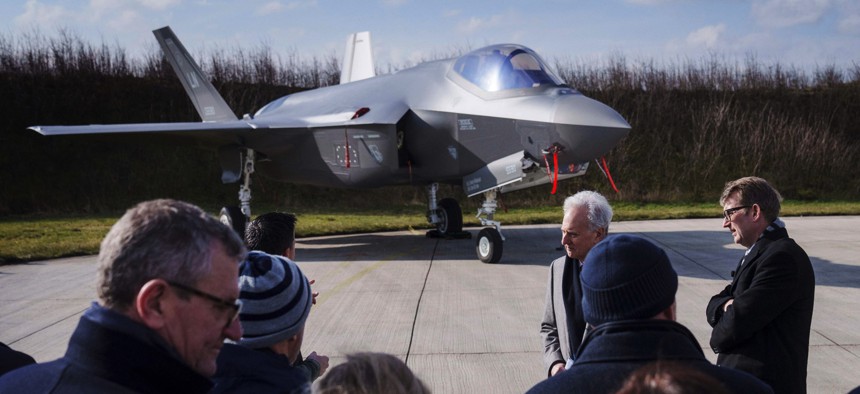
Denmark's Minister of Defence Troels Lund Poulsen and US Ambassador to Denmark Alan Leventhal attend an event of the US Air Force visits with five US F-35 fighter jets at the Danish Airbase Fighter Wing Skrydstrup in Jutland, Denmark, on March 10, 2023. BO AMSTRUP/Ritzau Scanpix/AFP via Getty Images
F-35 Sales Rise as Russian Invasion Grinds On
Air Force general says recent deals show how NATO allies are stepping up as the U.S. focuses on China.
Vladimir Putin’s invasion of Ukraine boosted F-35 sales as NATO is “stepping up to the plate” to deter Russia, according to the Air Force’s top Europe commander.
Allied nations know that the U.S. is focused on China, said Gen. James Hecker, commander of U.S. Air Forces Europe and Air Forces Africa. So when the U.S. decided to move F-16s from Spangdahlem Air Base in Germany to Kadena Air Base in Japan, it didn’t come as a surprise to NATO, he said.
The general has been telling NATO “all along” that “they have to become less dependent on us and more dependent upon themselves, so we're on that road going forward.”
And NATO is stepping up to the plate, Hecker said at a Mitchell Institute for Aerospace Studies event on Wednesday.
Since Russia’s invasion of Ukraine, four countries committed to buying F-35s, showing the “exact opposite” effect that Putin intended, Hecker said.
Finland, Switzerland, and Germany all signed Letters of Offer and Acceptance for F-35s in the last year. Canada announced its formal procurement agreement in January.
By 2034, more than 600 F-35s will be operating in Europe, Hecker said, and “out of those 600, there's only going to be about 50 that are U.S.—so over 90 percent are going to be our partners and allies.”
Sweden and Finland’s bid to join NATO will bring a lot to the fight, Hecker added, pointing to the former’s plan to upgrade to Gripen E/Fs and the latter’s effort to buy 60 F-35s.
“They provide a great capability and great geography that is going to help us should we have to invoke Article Five—we obviously hope that we don't,” he said.
Hecker said the Air Force, which began flying intensive combat air patrols in Europe after the Russian invasion last year, has now throttled back to “steady state” operations: routine missions intended to help keep the conflict contained inside Ukraine.
“We will do some combat air patrols, fully loaded with live missiles and things for deterrence, but what I think is even more of a deterrent is now when we deploy units over there, we practice missions that we would actually do, should we have to invoke Article Five,” Hecker said.
The Air Force also intends to ask all F-35 customers to help fund the cost of upgrading the engine that powers the jet, Breaking Defense reported.
The upgrade, which will add power and cooling for next-gen weapons and systems, will be ready late in the first quarter or early in the second quarter of fiscal year 2030, F-35 Joint Program Office spokesperson Russell Goemaere told Defense One.
When asked how long it will take to retrofit existing F-35s with the engine upgrade, Goemaere said that decision will come after the program’s acquisition strategy is finalized.
The Air Force is requesting 48 F-35As in its 2024 budget request, five more jets than Congress approved last year. The service has about 350 F-35s and plans to buy a total of 1,763.





